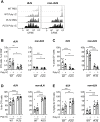Hyperuricaemic UrahPlt2/Plt2 mice show altered T cell proliferation and defective tumor immunity after local immunotherapy with Poly I:C
- PMID: 30383838
- PMCID: PMC6211752
- DOI: 10.1371/journal.pone.0206827
Hyperuricaemic UrahPlt2/Plt2 mice show altered T cell proliferation and defective tumor immunity after local immunotherapy with Poly I:C
Abstract
Hyperuricaemia is associated with various metabolic dysfunctions including obesity, type 2 diabetes mellitus, hypertension and in general metabolic syndrome, which are all associated with increased risk of cancer. However, the direct association between elevated uricemia and cancer mortality still remains unclear. In this study, we used a mouse model of hyperuricemia, the Urahplt2/plt2 (PLT2) mouse, to investigate the effect of high uric acid levels on anti-tumor immune responses and tumor growth. In normo-uricaemic C57BL/6 mice injected with B16 melanomas, immunotherapy by treatment with Poly I:C at the tumor site delayed tumor growth compared to PBS treatment. In contrast, Poly I:C-treated hyper-uricaemic PLT2 mice were unable to delay tumor growth. Conventional and monocyte-derived dendritic cells in the tumor-draining lymph nodes (dLN) of C57BL/6 and PLT2 mice were similarly increased after Poly I:C immunotherapy, and expressed high levels of CD40 and CD86. CD8+ T cells in the tumor-dLN and tumor of both WT and PLT2 mice were also increased after Poly I:C immunotherapy, and were able to secrete increased IFNγ upon in vitro restimulation. Surprisingly, tumor-specific CD8+ T cells in dLN were less abundant in PLT2 mice compared to C57BL/6, but showed a greater ability to proliferate even in the absence of cognate antigen. These data suggest that hyperuricaemia may affect the functionality of CD8+ T cells in vivo, leading to dysregulated T cell proliferation and impaired anti-tumor activity.
Conflict of interest statement
The authors have declared that no competing interests exist.
Figures





References
-
- Micucci C, Valli D, Matacchione G, Catalano A. Current perspectives between metabolic syndrome and cancer. Oncotarget. 2016;7(25):38959–72. Epub 2016/10/23. doi: 10.18632/oncotarget.8341 . - DOI - PMC - PubMed
Publication types
MeSH terms
Substances
LinkOut - more resources
Full Text Sources
Medical
Molecular Biology Databases
Research Materials

